 |
Age: 150 million years
Period: Jurassic
Location: Peipiao, Liaoning , China
Like all other living things, sturgeon fish, which belong to the order Acipenseriformes, have no evolutionary forebears in the fossil record. Throughout geologic history, they have always existed as sturgeon. This fact once again dramatizes the "intermediate form" dilemma, one of the major problems facing Darwinists.
The paleontologist Colin Patterson revealed the absence of any intermediate forms that might be proposed by Darwinists, by not referring to such forms at all in his book Evolution. He made the following admission in a letter to those people wondering why this was so:
"I fully agree with your comments on the lack of direct illustration of evolutionary transitions in my book. If I knew of any, fossil or living, I would certainly have included them. As a paleontologist myself, I am much occupied with the philosophical problems of identifying ancestral forms in the fossil record. You say that I should at least 'show a photo of the fossil from which each type of organism was derived.' I will lay it on the line—there is not one such fossil for which one could make a watertight argument." (From a letter dated 10 April, 1979, quoted in L. D. Sunderland's Darwin's Enigma: Fossils and Other Problems, 4th edition, Master Books, 1988
 |
Age: 5 million years
Period: Pliocene
Location: Marecchia River Formation, Poggio Berni, Rimini, Italy
The late evolutionist paleontologist Stephen Jay Gould admitted how fossils have never supported the theory of evolution:
"The extreme rarity of transitional forms in the fossil record persists as the trade secret of paleontology. . . . We fancy ourselves as the only true students of life's history, yet to preserve our favored account of evolution by natural selection we view our data as so bad that we never see the very process we profess to study." (Stephen Jay Gould, "Evolution's Erratic Pace," Natural History, Vol. 86 (5), May 1977, p. 14)
Evolutionists refer to this as an enigma. But in fact, there is no enigma here at all, but a manifest truth: Fossils demonstrate the fact of Creation.
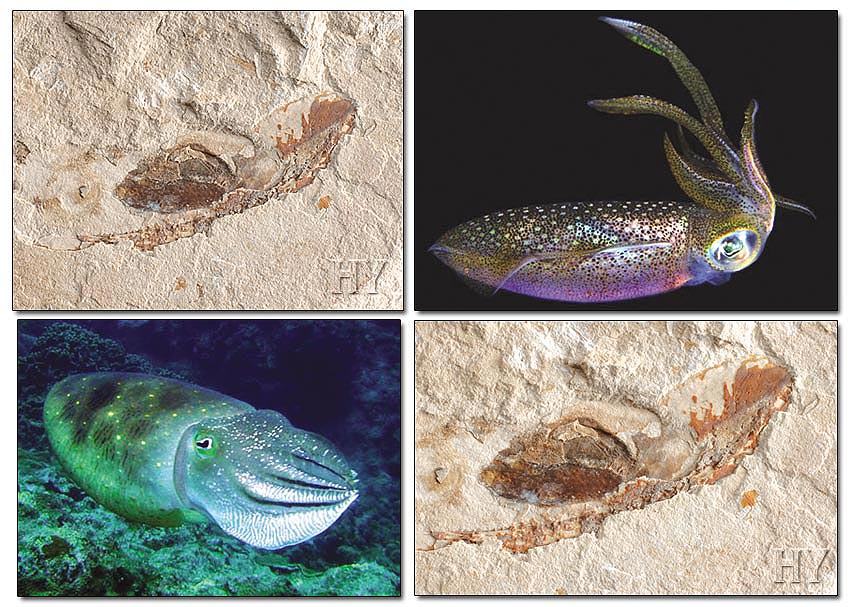 |
Age: 95 million years
Period: Cretaceous
Location: Haqel, Lebanon
If Darwinists maintain that living things are descended from one another, then they can prove these claims only by revealing fossils of intermediate forms that existed in the past. The intermediate forms they have to find must be life forms interposed between two fossil species, but with missing or half-developed organs.
If, for example, invertebrates such as squid evolved into fish, as evolutionists maintain, then a large number of "half-squid" and "half-fish" creatures must once have existed. And we should constantly be finding their remains in the fossil record.
Yet even though digs have been conducted all over world ever since Darwin's day and countless fossils have been unearthed, not one single intermediate form has ever been found. As this 95-million-year-old fossil shows, squid have always existed as squid.
 |
Age: 95 million years
Period: Cretaceous
Location: Lebanon
Like all other fish, stingrays have always existed as stingrays. Darwinist hypotheses, claims and theses are of no scientific worth, because all the scientific data, beginning with fossil findings, refute its assertions. The hoaxes, distortions and propaganda to which Darwinists resort in order to keep their theories alive are pointless.
As the 95-million-year-old stingray pictured here shows, living things tell us that they did not evolve, but were created, and this fact is impossible to be concealed.
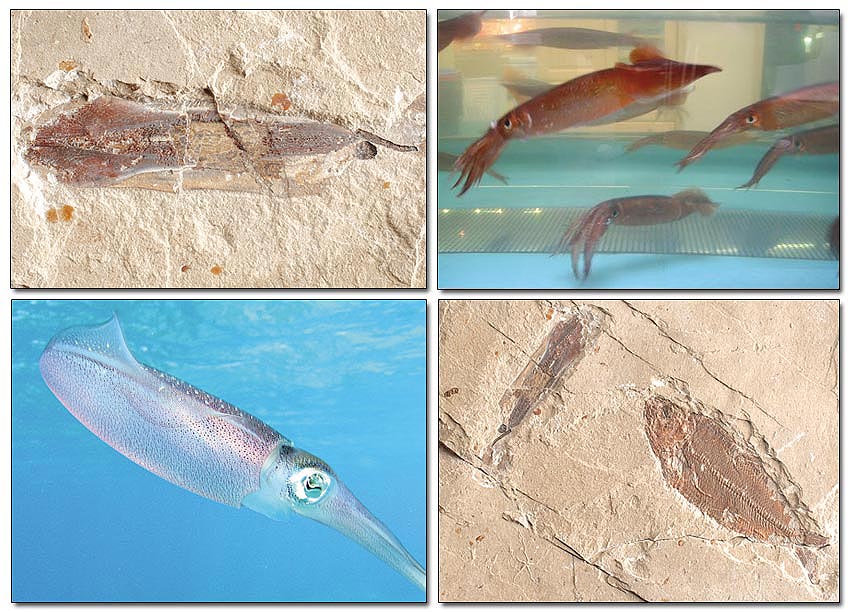 |
Age: 95 million years
Period: Cretaceous
Location: Lebanon
The theory of evolution, which has been kept alive ever since Darwin's day through hoaxes and distortions, has been defeated in the face of 21st century science. The most important findings to demolish evolution are the hundreds of millions of fossils belonging to some 250,000 species. Each one of these fossils has revealed that living things emerged suddenly, with all the characteristics they possess today, and that they have not undergone the slightest change over the course of millions of years.
One such fossil is the 95-million-year-old squid pictured here. Squid, that have remained unchanged for 95 million years, indicate one single truth: Life forms did not evolve, but were created.
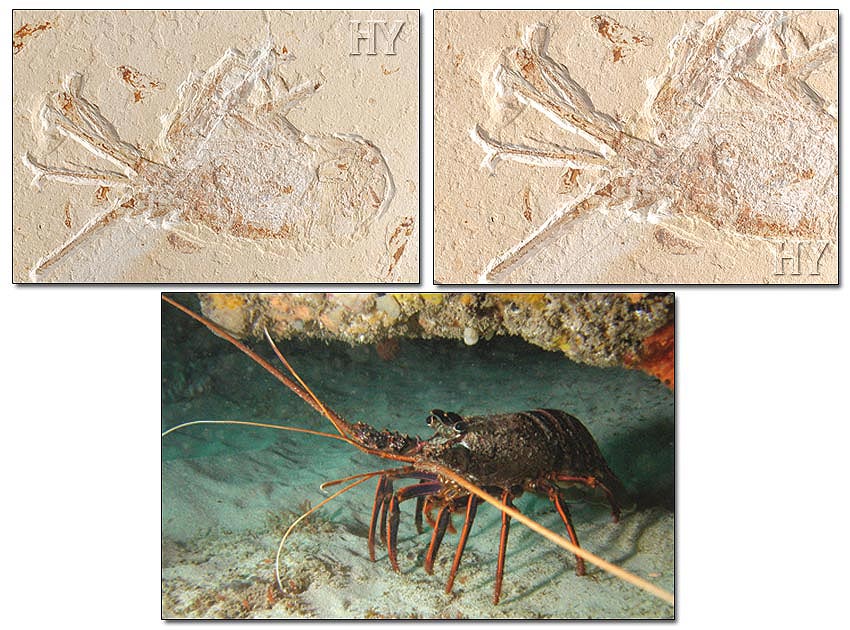 |
Age: 95 million years
Period: Cretaceous
Location: Lebanon
The fossilized lobster pictured here, a member of the family Palinuridae, reveals that these crustaceans have remained exactly the same for the last 95 million years. The way that species undergo no changes over millions of years is referred to as "stasis," and this represents a major predicament for evolutionists. Stephen Jay Gould, one of those evolutionists who has often stated that the fossil record does not support the theory of evolution, said this on the subject in an article in Natural History magazine in 1993:
"[S]tasis, or nonchange, of most fossil species during their lengthy geological lifespans was tacitly acknowledged by all paleontologists, but almost never studied explicitly . . . [T]he overwhelming prevalence of stasis became an embarrassing feature of the fossil record, best left ignored as a manifestation of nothing (that is, nonevolution)." (Stephen Jay Gould, "Cordelia's Dilemma," Natural History, February 1993, pp. 10-18)
There is only one reason why evolutionists describe the stasis in the fossil record as an embarrassment: That living things have never changed means the invalidation of the theory of evolution. This fact, which demonstrates that evolution never happened, confirms the fact of Creation.
 |
Age: 95 million years
Period: Cretaceous
Location: Lebanon
Mantis shrimps, which have survived unchanged ever since the Carboniferous period (354 to 290 million years ago), are a life form that invalidates Darwinism. It is impossible to provide any evolutionary explanation for a creature that remains unaltered for 300 million years.
The mantis shrimp pictured here is 95 million years old, yet is completely identical to both those that lived 300 million years in the past and specimens alive today.
 |
Age: 95 million years
Period: Cretaceous
Location: Lebanon
All the puffer fish fossils unearthed during the last 150 years are identical in every way to puffer fish alive today. If evolutionists' claims were true, then a great many fossils of semi-developed fish should have been excavated. Yet no such fossil ever has been, because no such intermediate form ever existed. The 95-million-year-old fossil pictured here is proof that puffer fish have always existed as puffer fish.
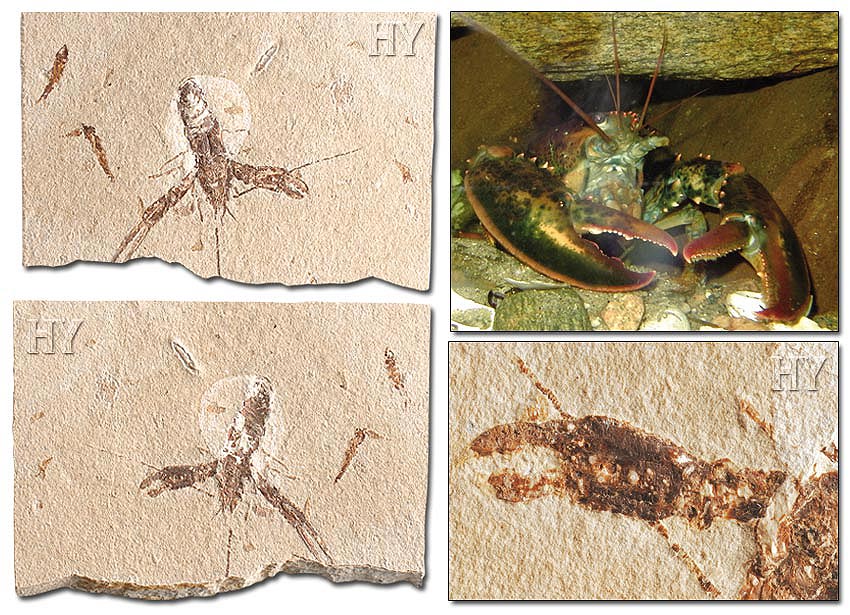 |
Age: 95 million years
Period: Cretaceous
Location: Lebanon
The fact that concrete evidence, such as fossils, argue against Darwinism cannot be concealed. Even evolutionists who have the ability to evaluate modern-day scientific findings in an unbiased manner admit it is plain to see that the fossil record opposes the theory of evolution.
In his book In Search of Deep Time, Henry Gee states that there is no accumulation of evidence to support the theory of evolution in the fossil record—and that, on the contrary, the evidence at hand is interpreted by evolutionists in the light of their own preconceptions:
"Many of the assumptions we make about evolution, especially concerning the history of life as understood from the fossil record, are, however, baseless." (Henry Gee, In Search of Deep Time, Ithaca: Cornell University Press, 1999, pp. 1-2.)
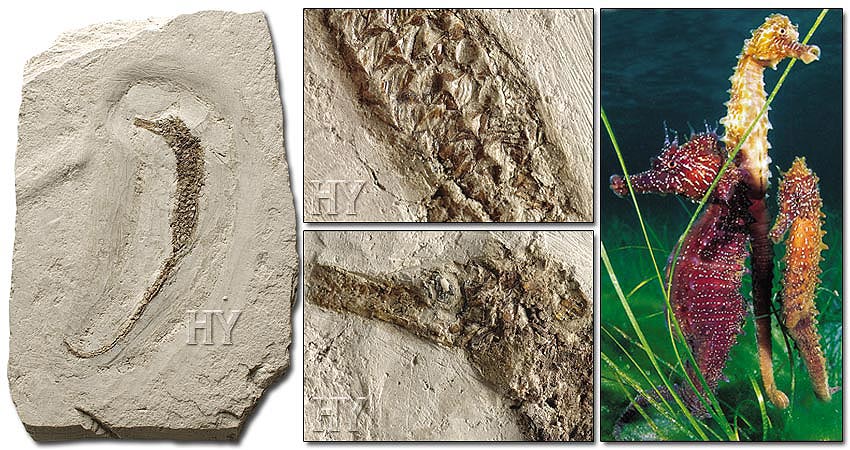 |
Age: 5 to 1.8 million years
Period: Pliocene
Location: Marecchia River Formation, Italy
Seahorses have always existed as seahorses, and are neither descended from not turned into any other life form. This fossil, which is proof that these creatures have never changed over millions of years, also declares that evolution is a lie. The origin of life does not lie in evolution. God, the Almighty and Omniscient, created the universe and all things within it.
 |
Age: 95 million years
Period: Cretaceous
Location: Haqel, Lebanon
None of the research conducted to date has been able to discover a single life form that represents the supposed evolutionary forebear of the mantis shrimp. No findings indicate that mantis shrimp came into being through any process of evolution. Every fossil unearthed shows that mantis shrimp have always existed as mantis shrimp and have remained unchanged for millions of years.
One such fossil is the 95-million-year-old mantis shrimp specimen pictured here.
 |
Age: 95 million years
Period: Cretaceous
Location: Haqel, Lebanon
You read pro-evolutionary reports in magazines and newspapers and you see similar programs and documentaries on television, not because Darwinism is a scientific viewpoint, but rather, there are tireless efforts to support it out of ideological concerns. Darwinism is the supposed scientific foundation for materialism and atheism.
No one who accepts Darwinism's invalidity can support materialism and atheism. That is why, despite all scientific findings and evidence arguing against the theory of evolution, these facts are ignored, and Darwinism continues to be defended through lies and distortions.
One of the proofs that evolutionists refuse to acknowledge are the fossils, now numbering in the millions, each one of them clear proof of Creation. Like the 95-million-year-old puffer fish pictured, all fossils tell us that living things never evolved, and that God created them all.
This is a two-sided "mirror image" fossil, traces of which can be seen on either surface of the rock.
| This is a two-sided "mirror image" fossil, traces of which can be seen on either surface of the rock. |
 |
Age: 95 million years
Period: Cretaceous
Location: Haqel, Lebanon
Science has proved that evolutionists' claims regarding the origin of life are mere nonsense, and the theory of evolution has collapsed in the face of many concrete findings.
One of the countless bits of evidence to demolish the theory of evolution is the lack of any imaginary intermediate forms in the fossil record. Every fossil unearthed shows that all living species came into being with all their characteristics fully present, and remained unchanged from then on. The 95-million-year-old stingray in the picture is one such specimen. There is no difference between this fossil and stingrays alive today; and all stingrays have been exactly the same ever since they first appeared in the fossil record.
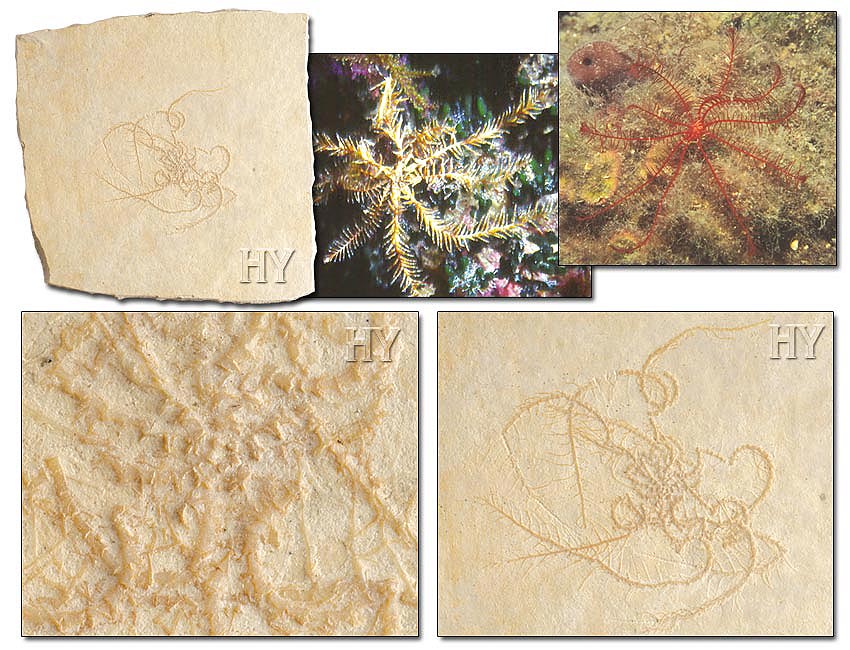 |
Age: 150 million years
Period: Jurassic
Location: Solnhofen Formation, Germany
The wealth of the fossil record poses a serious dilemma for evolutionists. These fossils present those people unwilling to understand the origin of life with a fully detailed, complete picture. Living things emerged separately, each one in a single moment and with all its different structures, with no imaginary "intermediate evolutionary" forms preceding them. The 150-million-year-old sea lily in the picture is one of the proofs in question.
 |
Age: 95 million years
Period: Cretaceous
Location: Haqel, Lebanon
Darwin's hypotheses regarding the origin of life were based on no scientific findings or experiments. However, with the support and encouragement he received from materialist biologists of the time, Darwin constructed a theory out of these hypotheses. According to his theory, all living things were descended from a supposed single primitive ancestor, underwent minute changes over a very long period of time, and thus became different from one another.
This hypothesis has been confirmed by no concrete scientific findings, neither in Darwin's own time nor in the intervening 150 years. On the contrary, all the fossils unearthed have revealed that living things have remained unchanged, often for tens of millions of years and sometimes for hundreds. His theory has collapsed in the face of science. One of the proofs of that collapse is the 95-million-year-old mantis shrimp pictured.
 |
Age: 95 million years
Period: Cretaceous
Location: Lebanon
In the fossil record, it is sometimes possible to come across remains of living things bearing features belonging to another species. Darwinists, interpreting these findings in a prejudiced manner, claim that these fossils confirm their theories. But that is a grave error, because one living thing having features similar to another's is not characteristic of any "intermediate form." The platypus, for example, lives in Australia, and despite being a mammal, lays eggs like reptiles. In addition, it has a beak resembling that of birds. Scientists describe the platypus as a "mosaic form." Even leading evolutionists admit that these cannot be regarded as intermediate forms.
Instead of engaging in distorted interpretations regarding mosaic forms, Darwinists need to produce concrete evidence to prove that species descended from one another by way of minuscule changes. But this they can never do, because no such process ever took place.
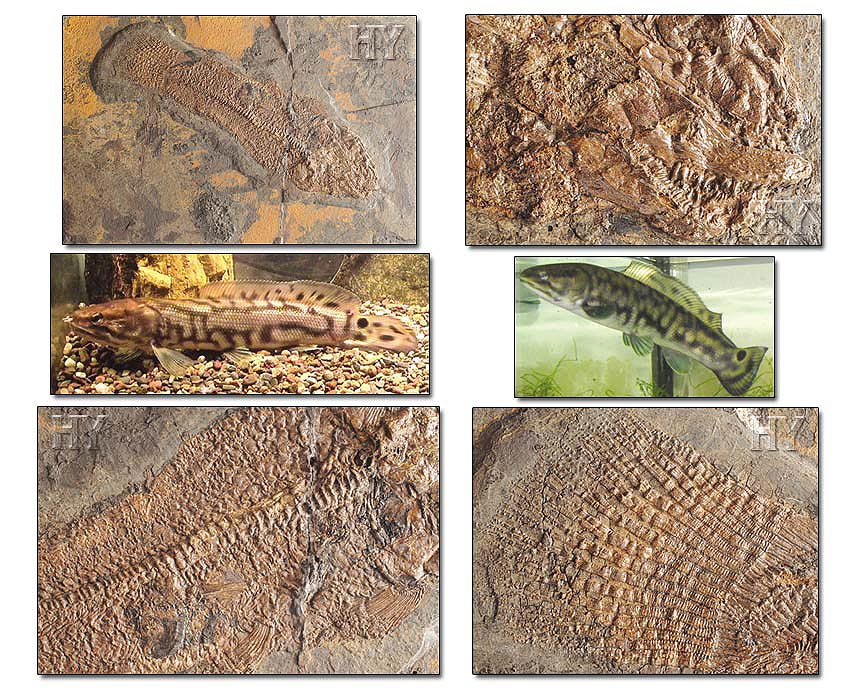 |
Age: 50 million years
Period: Eocene
Location: Messel Quarry, Germany
The theory of evolution is not based on scientific fact, but is maintained by means of invented scenarios and propaganda, and it is impossible to find any fossils supporting this fictitious theory. Darwinists have written an imaginary natural history, and have attempted to find fossils to fit it. Yet the exact opposite actually happened: Every new fossil places the theory of evolution in an even worse predicament.
The bowfin fossil pictured dates back 50 million years. Its sharp teeth have been perfectly preserved, and its skeletal structure can be seen to be identical to that of specimens alive today.
 |
Age: 23 -5 million years
Period: Miocene
Location: Marecchia River Formation, Poggio, Rimini, Italy
Sea horses (Hippocampus sp.) generally cling onto plants with their tails, and swim upright with their dorsal fin because they lack tail fins. Their ability to swim upright is based on their being able to fill their flotation sacs with air very quickly.
Pictured is a fossilized sea horse discovered in rock beds in northern Italy. This sea horse, from Miocene period, is exactly the same in terms of all its organs and structures—its skeleton, flotation sac and gills—as present-day sea horses. Sea horses have remained unchanged since they first begin appearing in the fossil record, and fundamentally invalidate evolutionist claims.
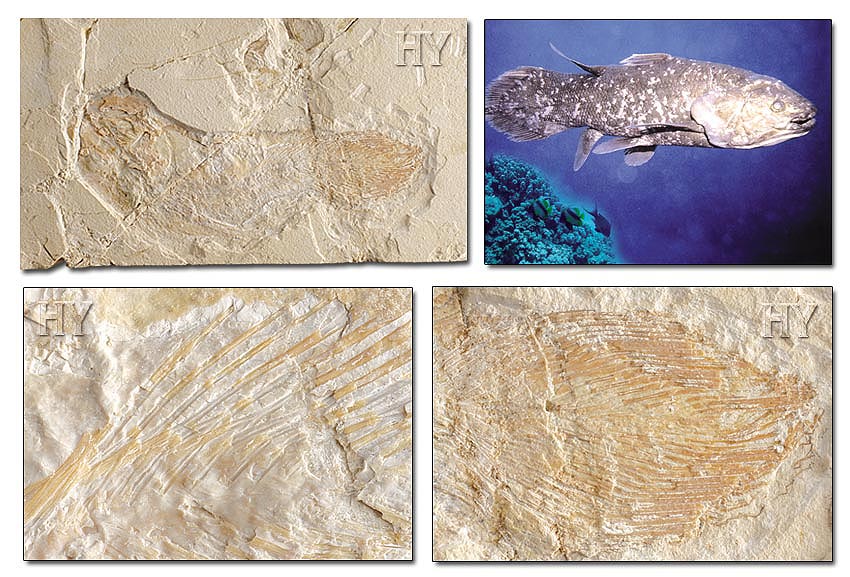 |
Age: 95 million years
Period: Cretaceous
Location: Haqel, Lebanon
In 1938, Darwinists suffered a terrible disappointment with the capture of a living coelacanth, a fish they had long depicted as so-called evidence of the transition of vertebrates from the sea to dry land. In the years that followed, some 200 coelacanths were caught. In 1987, Professor Hans Fricke of the Max Planck Institute observed these creatures in their natural habitat by descending to a depth of 200 meters off the East African Comoro Islands, in a submarine named Geo. He observed that their bony fins had no functional link to the limbs that permit walking in tetrapods (four-footed animals).
The April 2003 issue of Focus magazine reported the findings from this research:
"The flexible fins had no similar functions to those in four-footed land vertebrates. These allowed the creature to swim head-down and in all directions, even backwards." (Focus, April 2003)
With its structures that have remained unchanged for 400 million years, the coelacanth places evolutionists in a highly difficult position. Bear in mind, too, that continental shifts have taken place over those 400 million years, during which the coelacanth never changed at all.
It can be seen that evolutionists are in an utterly hopeless position. Moreover, the coelacanth exhibits a profound gulf between the marine and terrestrial life forms, between which the theory of evolution presumes a transitional link.